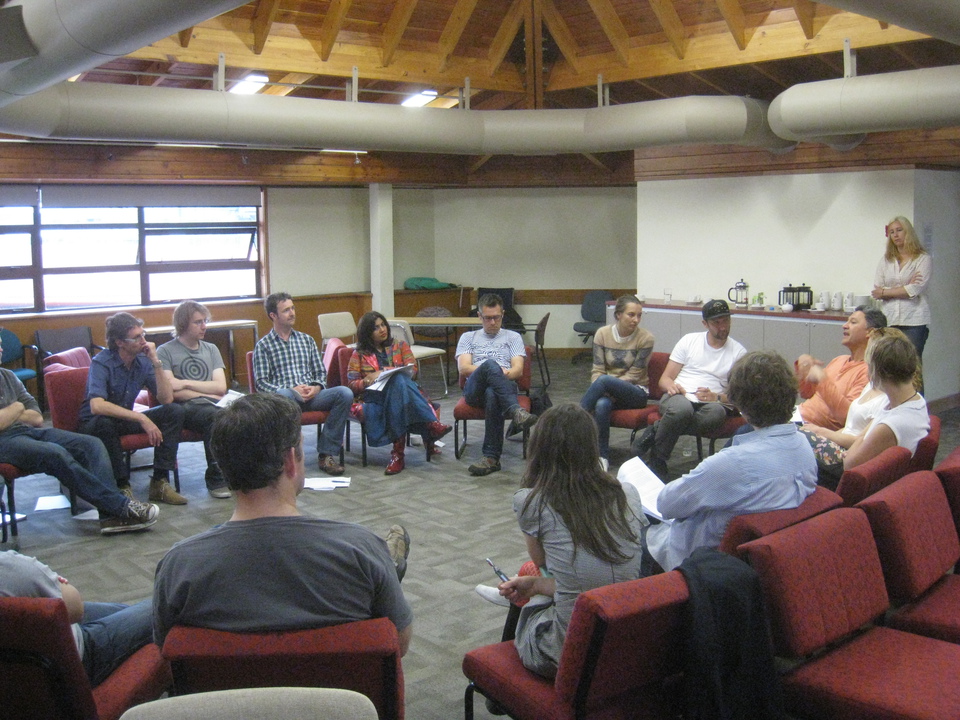Nail your short film script
By Gina Dellabarca from Show Me Shorts So you’ve got a great idea for a short film. If you’re not an experienced writer and you don’t have one on board, here are some tips and advice for turning your premise into a workable script. A great screenplay is a magical thing. It crafts your short […]

By Gina Dellabarca from Show Me Shorts
So you’ve got a great idea for a short film. If you’re not an experienced writer and you don’t have one on board, here are some tips and advice for turning your premise into a workable script.
A great screenplay is a magical thing. It crafts your short film idea into a coherent blueprint that you can use to convey your premise to others and get them excited about your project. It forms the foundation and reference point for most of the key decisions guiding the creation of your film.
Your first script will be crap. But you have to start somewhere. Get it out on paper and don’t stress about making it perfect.
“If you don’t have time to read, you don’t have the time — or the tools — to write. Simple as that.” – Stephen King
WRITE A TREATMENT
A treatment is an outline of your short film idea; it’s usually not more than a page long, and may be only a few paragraphs. It gives an outline of the story, and provides some of the details about character, setting and tone.
It is useful to start with a treatment and share it with others to get some early feedback and see if your premise has legs. It’s also a useful exercise for you to hone in on exactly what it is you want to say.
Take the time to visualise the film, and consider how you will tell it economically with a minimum of locations, characters and special effects. Your treatment should also give an indication of the story arc and structure.
“The first draft of everything is shit.” – Ernest Hemingway
GET THE NUTS AND BOLTS RIGHT
When it comes time to write your idea into a script, you can use normal word processing software such as Microsoft Word. Some professional tools can also be useful: these applications can help you keep track of different drafts and format your script to international industry standards.
– Final Draft is the go-to tool for screen writing. This is software you download and install on your computer.
– Celtx is a complete online workspace where you can write, storyboard, draw camera and lighting setups, break down your script into categories (i.e. props, cast, locations), schedule your shoot, prepare call sheets and budget. The scripting component is free. The other parts require a subscription fee.
– Google Drive is a free cloud-based platform allowing you to store and share text documents and spreadsheets online. This is useful if you are co-writing.
The general rule of screenplays is that one page of the script equals one minute on screen. So think about the length of the film you are writing and don’t make your script overly long. Many short film festivals set a maximum length for films of around 20 minutes, and it is often easier to get screenings and distribution for shorter films.
Your script should be formatted as follows:
– Include a title page with the name of the film and the author
– Use 12-point Courier font
– Use single line spacing, except for after scene headings and blocks of dialogue, where you should use double spacing.
– Number your pages
– Print on plain A4 white paper
– Punch two holes and insert brass paper fasteners (often called ‘brads’)
Remember to use your spell-check. Spelling and grammar mistakes detract from the story and make you seem unprofessional and careless.
“Write drunk, edit sober.” – Ernest Hemingway
START WRITING
Dive straight in.
What is happening or has just happened at the time your story begins? It better be interesting and capture your audience right away or you can be sure they’ll quickly switch off, check their phone or wonder what to have for dinner.
Who is your main character?
Most short films centre around a single protagonist. You can write a film with more than one central character, but be aware this may dilute the emotional intensity of the story. Identify the protagonist up front for the audience, and give us a reason to care about them. Save the cat is a popular screenwriting trick that introduces us to the main character right away, showing them performing a selfless act and making us like them.
Describe your characters not just in terms of their age and appearance. Their mannerisms and demeanour give clues to the audience about their core values. Do they move quietly, have nervous tics or an easy smile? These quirks lend something to our imagination and can signal later plot developments.
What’s their problem?
Usually your protagonist will face a problem that sets them on a quest (the hero’s journey) and drives the action of the film. The problem can be one that exists between the protagonist and another character, something in their world they have to change or something about themselves that requires personal growth.
The satisfaction your audience will experience rests with your ability to take them on a journey with your protagonist as they struggle to overcome obstacles and eventually succeed (or fail) in their quest. Common script problems include central characters who face too few obstacles, are passive or have no clear motivation.
What are the stakes?
You can make your film more compelling by upping the intensity of the peril you put your characters in on their journey. What will happen if they don’t solve their problem? If the answer is “not much” then the stakes aren’t high enough.
How should the story unfold?
When you hear people talking about ‘the story arc’, they are referring to the traditional build-up of action that develops over the course of the film. This peaks around ¾ of the way through for feature films, but in short films it often marks the ending. As your action unfolds, make sure the obstacles confronting the character build so the hardest thing the character must do happens at the climax.
Beginning (25%)
Introduce your protagonist and setting. Put a problem or situation they must deal with in their way. Explain why the problem must be dealt with.
Middle (50%)
Develop the situation, using action and behavioural choices to advance the storyline. Throw in some obstacles for them to deal with.
End (25%)
Tie it all together with a clever twist that completes the journey. Surprise endings are worth the time it takes to think them through.
Be true to your genre.
The reason genres exist is because these are tried-and-tested formulas for telling a story that engages your audience. Be very careful if you plan to mess with that, as this will mess with your audience. Audiences love surprises and having their expectations subverted, but the pay-off will have to be exponentially more rewarding for them.
Show us, don’t tell us.
Dialogue is notoriously difficult to get right. Remember film is a visual medium and actions speak louder than words. A common mistake is too much dialogue, or a reliance on dialogue to tell the story.
Cut the crap.
Cut out anything superfluous to your story. Simplify by combining characters. There’s no time for sub-plots and anything that doesn’t drive your story forward in a short film. Don’t try and do the director’s job for them by putting in too much detail; you don’t need to write camera directions. Oh, and sorry… but you probably can’t afford the helicopter scene or zebra wranglers.
“Two things a good writer needs — lots of time and an arsehole-proof fence.” – Nick Ward
LEARN FROM THE PROS
Above: Participants and mentors at the 2012 Short Film Lab
If you’re having trouble or want to improve the quality of your writing, get some expert advice. There is plenty of help available, so take a course and find out how to do it right. The following are some training organisations that provide professional development for aspiring short film writers, particularly recommended by Show Me Shorts:
– The Short Film Lab, run jointly by Show Me Shorts and Script to Screen, is a hothouse mentoring scheme for New Zealand writers to workshop fresh new ideas for short films.
– Script to Screen is a training organisation for the New Zealand film industry, especially writers.
– University of Auckland provides various courses in screen production.
– Kathryn Burnett’s Beginner’s Guide to Screenwriting and other workshops are raved about by aspiring and established writers alike.
Other professional development options for writing short film scripts include:
– AUT University – Masters in Creative Writing for Screenwriters
– NZ Writers’ College – Scriptwriting
– Script Factory Training Course
– South Seas – Film & Television Diploma
– The Film School – Introduction to Film and Television Production
– Unitec – Bachelor of Performing and Screen Arts
– University of Auckland – SCREEN 705
– Victoria University of Wellington – FILM 305
“Getting stuck in a story problem is like being stuck in a maze – there are so many ways you can go and so many blind alleys you could follow. When you find yourself in this place it’s best to just stop. Leave the maze immediately, go for a walk and eat some cake. (Doughnuts also fine.) The maze will still be there when you get back but you’ll probably get in through a different entrance.” – Kathryn Burnett
ASK FOR FEEDBACK
Once you have completed writing your first draft, the hard work is not yet over. You need to send it out to potential collaborators and respected professionals for feedback. This can be scary, but being open to feedback and constructive criticism on your work is one of the most important parts of screenwriting.
If you don’t already have a network you can send your script to Scriptease. The New Zealand Writers’ Guild (NZWG) Script Reader Service is a reviewing service that provides professional, respectful and constructive feedback. The NZWG also offers virtual writers’ ‘huddles’ (NZWG Script Swap Virtual Writer Groups). Through these virtual groups, participants are able to safely and securely provide each other with positive feedback on scripts, offer support and encouragement, and share in successes.
“Remember: when people tell you something’s wrong or doesn’t work for them, they are almost always right. When they tell you exactly what they think is wrong and how to fix it, they are almost always wrong.” – Neil Gaiman
REWRITES ARE NORMAL
Once you have received feedback on your script, look particularly at the parts of the script that didn’t work for the reader — but don’t necessarily follow every comment or suggestion you receive. Stay true to your original idea and don’t lose sight of the essential components that make your story unique and engaging.
Theme is a hard one to nail when you are writing a first draft. Your first few rewrites are a great time to analyse your theme now you have some perspective.
It is completely normal for a short film script to go through more than 20 drafts before it is ready to be made into a film. This process can take many years or just a few months. Practice makes perfect, so get writing.
“More than a half, maybe as much as two-thirds, of my life as a writer is rewriting. I wouldn’t say I have a talent that’s special. It strikes me that I have an unusual kind of stamina.” – John Irving
PROTECT YOUR STORY
You can’t protect an idea for a short film, only an ‘expression of an idea’, so once you’ve completed your script you should think about protecting it. There is no formal process for registration of copyright ownership of a script in New Zealand, but copyright is automatically assigned at the time you create the script. It is therefore a good idea to keep paper and electronic records of emails, correspondence, notes, treatments, previous drafts, etc relating to your script to help prove when copyright came into existence, should that become necessary.
We recommend you register your script with the NZ Writers Guild before you send it out to anyone, to avoid any potential issues over copyright infringements. There is a $35 charge for this service for members and $70 for non-members, and the registration lasts for 10 years. Hopefully you will have made your film by then!
“Start telling the stories that only you can tell, because there’ll always be better writers than you and there’ll always be smarter writers than you. There will always be people who are much better at doing this or doing that — but you are the only you.” – Neil Gaiman
















